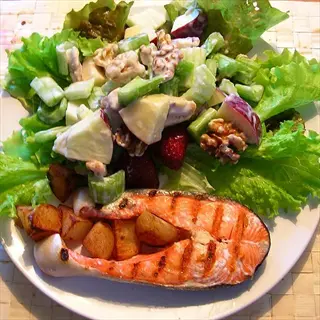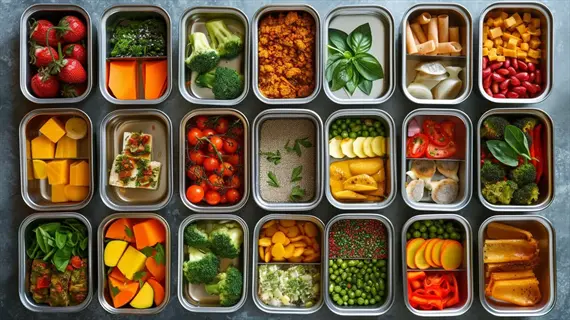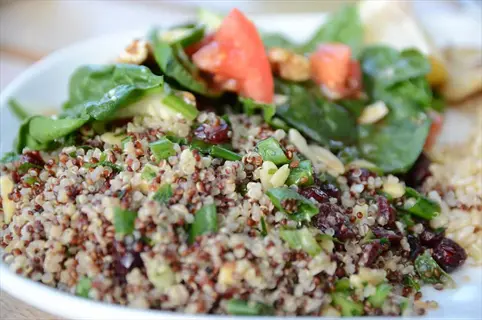Balanced Diet Benefits for Optimal Health

Written by
Leilani Ibeh
Reviewed by
Prof. Graham Pierce, Ph.D.A balanced diet provides sustained energy, focus, and disease prevention.
Proteins, vitamins, and minerals are essential nutrients that enhance cellular functions.
Planning meals can help with nutrition, reduce waste, and save money.
Plant-based proteins contain all the essential amino acids without using animal products.
Being a smart shopper at the grocery store will maximize freshness and minimize processed foods.
Being consistently dehydrated and consuming sources of fiber will improve digestion and help the body remove toxins.
Article Navigation
The positive effects of a well-balanced diet begin with the way food is viewed, that is, as nourishment and not a punishment. I help my clients view food as a colorful plate rather than focusing on the number of calories it contains. I am talking of bright vegetables, lean meats, and whole grains all working together. Your body thrives on variety, not restriction.
Do you feel sluggish after lunch? Do you have cravings in the afternoon? I experienced this too, until I carefully balanced my nutrients. Having a flexible approach gives you energy throughout the day. It changes how you feel without difficult rules.
Say goodbye to restrictive diets where you're hungry and miserable. I'll show you patterns you can sustain with foods you enjoy. Imagine walking away from meals feeling satisfied and your body getting stronger. That's the real power of enjoying balanced eating simply.
Essential Nutrients in Focus
Depending on the type of carbohydrate being utilized, carbohydrates nourish the body in different ways. Complex carbohydrate(s) such as those existing in oats release energy in such a manner that you feel full for a much longer time, whereas simple carbohydrates, such as the kind existing in white bread, give you a quick rush of energy and some plots, too. Therefore, I select steel-cut oats instead of those sugary cereals every morning.
When you blend plant proteins correctly, they create nutritious complete proteins. For instance, if you eat rice with beans or hummus with whole-grain pita bread, you get all the necessary amino acids. My clients enjoy lentil soups and tofu stir-fries for muscle building without meat.
Fats operate differently in your system. The unsaturated fats in avocados flow through you like a liquid that nourishes your cells. The saturated fats seem like sticky sludge compared to them. Think of olive oil and butter, and you know why I choose avocado as a source of heart health.
Increasing the pairing of nutrients also greatly increases absorption. Spinach and lemon juice can triple iron absorption. Tomatoes and olive oil can also increase lycopene absorption. I teach clients ideas about these combinations that help their meals work harder for their health without any extra work.
Carbohydrates
- Energy Mechanics: Complex carbohydrates like oats break down slowly, providing steady energy release over 3-4 hours without blood sugar spikes
- Fiber Benefits: Soluble fiber in apples binds to cholesterol for removal, while insoluble fiber adds bulk to support regular bowel movements
- Daily Planning: Include 1-2 complex carb sources per meal like sweet potatoes or quinoa for sustained physical and mental energy
Proteins
- Amino Acid Profiles: Animal proteins contain complete amino acid profiles, while plant proteins require combinations like rice and beans for full spectrum
- Muscle Support: Adequate protein intake repairs muscle tissue after activity and prevents age-related muscle loss (sarcopenia)
- Satiety Mechanism: Protein triggers peptide hormones that signal fullness to the brain, helping control appetite between meals
Fats
- Heart Protection: Monounsaturated fats in olive oil reduce LDL cholesterol and inflammation markers linked to cardiovascular disease
- Vitamin Absorption: Fat-soluble vitamins require dietary fats for transport through the lymphatic system before entering bloodstream
- Essential Fatty Acids: Omega-3s in salmon support brain function and reduce triglyceride levels by 15-30% in clinical studies
Vitamins/Minerals
- Synergistic Effects: Vitamin C converts plant-based iron into absorbable form while vitamin D enables calcium absorption in intestines
- Bone Protection: Calcium and vitamin D work together to mineralize bone matrix and prevent osteoporosis development over time
- Immune Support: Zinc activates T-cells that identify pathogens while selenium supports antioxidant enzyme production
Fiber & Water
- Digestive Health: Fiber feeds beneficial gut bacteria that produce short-chain fatty acids protecting colon lining
- Hydration Effects: Water regulates body temperature through sweating and maintains blood volume for nutrient transport
- Kidney Function: Proper hydration enables kidneys to filter 120-150 quarts (113-142 liters) of blood daily removing waste products

Omega-3 Fatty Acids
- Heart Benefits: Reduce triglycerides by 15-30% and lower blood pressure through anti-inflammatory effects on arteries
- Brain Support: Constitute 40% of brain's fatty acids with DHA critical for neuron membrane fluidity and signaling
- Daily Intake: Aim for 250-500mg EPA+DHA through 2 servings of fatty fish weekly or flaxseed supplementation

B Vitamins
- Energy Conversion: B1, B2, B3 convert carbs into ATP while B5 synthesizes coenzyme A for fat metabolism
- Red Blood Cells: B6 and B12 support hemoglobin production carrying oxygen through bloodstream to tissues
- Nervous System: B12 maintains myelin sheaths around nerves ensuring proper electrical signal transmission

Vitamin D
- Bone Health: Enables intestinal calcium absorption at 30-40% efficiency rate for proper bone mineralization
- Immune Modulation: Regulates T-cell function reducing autoimmune responses while enhancing pathogen defense
- Sunlight Synthesis: 15 minutes midday sun exposure produces approximately 10,000-20,000 IU vitamin D3

Iron
- Oxygen Transport: Forms hemoglobin molecules carrying oxygen from lungs to all body tissues and organs
- Plant vs Animal: Heme iron from meat absorbs at 15-35% rate versus 2-20% for non-heme plant sources
- Absorption Boost: Pair with vitamin C sources to increase non-heme iron absorption by up to 300%

Magnesium
- Muscle Function: Regulates calcium flow in muscle cells enabling proper contraction-relaxation cycles
- Sleep Support: Activates GABA receptors in nervous system promoting deeper, more restorative sleep cycles
- Daily Needs: 310-420mg daily from sources like pumpkin seeds, dark chocolate, and leafy greens

Zinc
- Immune Activation: Required for T-cell development and cytokine production during immune responses
- Wound Healing: Supports collagen synthesis and cell membrane repair at injury sites throughout body
- Sensory Health: Concentrated in retina and taste buds supporting vision acuity and flavor perception
Practical Daily Eating Tips
Trade sugary beverages for energizing ones. A soda has the equivalent of ten sugar cubes in the can versus citrus-infused water. Unsweetened herbal teas are also lower in calories and hydrating. Choose refreshing, natural beverages every day, and your body will thank you!
To reduce the tendency to overeat, visualize the sizes of portions by comparing them to familiar objects. Lean protein should be the size of your palm, two 3-4 ounce portions. Grains will easily fit into the tennis-ball-sized half cup of the partition. Oil should be one teaspoon. That is the amount on the tip of your thumb.
Establish a meal prep pattern that accommodates your needs. Make all grains and proteins on Sunday for the week. Chop vegetables on Wednesday to pull together quick stir-fries. Put together freezer meals on Friday for those busy days. This system of meal prep saves hours and keeps meals fresh and flavorful.
Select cooking methods that conserve the nutrients in your food. Steaming vegetables retains 90% of the Vitamin C as opposed to boiling. Grilling removes excess fats from the food while adding flavor. Roasting at 425 degrees will caramelize the item in less than thirty minutes. This way, your meals become both healthier and tastier.

Hydration Choices
- Sugar Reduction: Replace soda with sparkling water infused with citrus slices or berries to cut 39g (1.4 oz) sugar per serving
- Herbal Benefits: Choose unsweetened hibiscus or chamomile tea over sweetened drinks to reduce calorie intake by 150 calories daily
- Electrolyte Balance: Add pinch of sea salt to water instead of sports drinks for natural electrolyte replenishment without artificial colors

Seasoning Alternatives
- Sodium Reduction: Use garlic powder, onion flakes, or citrus zest instead of salt to enhance flavors while lowering blood pressure risks
- Anti-inflammatory Boost: Incorporate turmeric and ginger into dressings and marinades to reduce inflammation markers by 20-30%
- Umami Enhancement: Substitute nutritional yeast or mushrooms for MSG-containing seasonings to add savory depth naturally

Snack Transformations
- Fiber Increase: Swap chips with air-popped popcorn or kale chips to boost fiber from 1g (0.04 oz) to 4g (0.14 oz) per serving
- Protein Upgrade: Replace candy bars with Greek yogurt and berries for 15g (0.5 oz) protein versus 2g (0.07 oz) protein in sugary snacks
- Prep Efficiency: Store pre-cut vegetables like bell peppers and cucumbers for instant access to crunchy, low-calorie options

Cooking Method Shifts
- Nutrient Preservation: Steam vegetables instead of boiling to retain 90% of vitamin C versus 40% loss in water-based cooking
- Fat Reduction: Use grill pans with ridges instead of frying to drain excess fats while creating flavorful char marks
- Time Savings: Roast sheet-pan meals at 425°F (220°C) for caramelized flavors in under 30 minutes

Grain Upgrades
- Fiber Boost: Choose quinoa instead of white rice for 5g (0.18 oz) fiber versus 0.6g (0.02 oz) per cooked cup
- Protein Advantage: Opt for farro over pasta to increase protein from 7g (0.25 oz) to 10g (0.35 oz) per serving
- Prep Tip: Batch-cook whole grains weekly for quick meal assembly
Visual Guides
- Protein Sizing: Match lean protein portions to palm size (3-4 oz or 85-113g) for adequate intake without excess
- Carb Comparisons: Visualize grain servings as tennis ball (1/2 cup or 64g cooked) to maintain 45-65% calorie goals
- Fat Measurement: Limit oils to thumb tip amount (1 tsp or 5ml) per meal for controlled healthy fat intake
Meal Timing
- Blood Sugar Balance: Eat every 3-4 hours to maintain steady glucose levels between 70-130 mg/dL (3.9-7.2 mmol/L)
- Evening Strategy: Finish dinner 3 hours before bedtime to optimize digestion and prevent acid reflux during sleep
- Hydration Rhythm: Drink 1 glass of water upon waking and before each meal for consistent hydration patterns
Mindful Practices
- Eating Pace: Chew each bite 15-20 times to trigger satiety signals reaching brain in 20 minutes
- Distraction-Free: Remove screens during meals to recognize fullness cues and reduce overeating by 25%
- Hunger Scale: Rate hunger from 1-10 before eating; stop at level 6 to prevent discomfort
Grocery Shopping
- Perimeter Strategy: Focus on fresh produce and proteins along store edges to avoid processed inner aisles
- Label Literacy: Check for added sugars under 5g (0.18 oz) per serving and avoid hydrogenated oils
- Seasonal Selection: Choose local in-season fruits and vegetables for peak nutrition and lower costs
Plate Composition
- Vegetable Priority: Fill half your plate with colorful vegetables before adding other components
- Protein Placement: Allocate quarter plate to lean proteins like fish or tofu for muscle maintenance
- Grain Moderation: Reserve remaining quarter for whole grains like brown rice or quinoa
Meal Planning Made Simple
Design your plate like an artist uses a canvas. Fill half with colorful vegetables, *one quarter* with lean proteins, and *one quarter* with whole grains. This balanced template works for every meal, whether breakfast bowls or dinner plates. I use this method to simplify my decisions while ensuring a daily nutrient balance.
Create your shopping list using seasonal treasures. Summer means berries and tomatoes at half their winter prices. Winter brings inexpensive citrus and squash. I check prices from week to week, buying in abundance when in season to freeze for later months.
Batch cooking changes your week! Roast three pounds of chicken while simmering some grains on Sunday, and you save at least thirty minutes every day by having easy ingredients. My clients regain five hours a week by using this smart strategy for quick meal preparation.
Proper food storage is essential to eliminate waste and ensure high quality. For example, herbs require water-filled jars as though they were fresh flowers. Grains should be stored in air-tight containers, including oxygen absorbers. I teach these methods in my classes so that produce will last days longer, which will reduce the number of grocery shopping trips.
Breakfast Essentials
- Protein Foundation: Include 20-30g protein from Greek yogurt or eggs to support muscle maintenance until lunch
- Complex Carbs: Add 1/2 cup oats or whole-grain toast for sustained energy release over 3-4 hours
- Healthy Fats: Incorporate 1 tbsp nuts or seeds for fat-soluble vitamin absorption and satiety
- Hydration: Start with 12 oz (355ml) water or herbal tea to replenish overnight fluid loss
- Sample Meal: Overnight oats with Greek yogurt, berries, and chia seeds
Lunch Structure
- Vegetable Base: Fill half plate with raw/cooked vegetables like spinach, carrots, or bell peppers
- Lean Protein: Add 3-4 oz (85-113g) chicken, tofu, or legumes for tissue repair enzymes
- Whole Grains: Include 1/2 cup quinoa or brown rice to maintain steady blood sugar levels
- Dressing: Use vinegar-based dressings instead of creamy options to save 100 calories per serving
- Sample Meal: Quinoa salad with chickpeas, roasted vegetables, and lemon-tahini dressing
Dinner Balance
- Color Diversity: Combine 3+ colored vegetables (broccoli, sweet potatoes, tomatoes) for phytonutrient variety
- Protein Rotation: Alternate between fish (2x/week), poultry (2x/week), and plant-based proteins (3x/week)
- Smart Starches: Choose high-fiber options like wild rice or barley instead of refined carbohydrates
- Light Evening Finish: Consume at least 3 hours before bedtime to optimize digestion during sleep
- Sample Meal: Baked salmon with roasted Brussels sprouts and farro pilaf
Snack Strategies
- Macro Pairing: Combine protein and fiber like apple slices with almond butter for balanced blood sugar
- Portion Control: Pre-package snacks in 150-200 calorie portions to prevent mindless overeating
- Hydration Focus: Choose herbal tea or infused water over juice to avoid added sugar spikes
- Timing: Schedule snacks midway between meals to maintain 3-4 hour eating intervals
- Sample Snack: Hummus with pre-cut vegetable sticks and whole-grain crackers
Weekly Meal Theme
- Meatless Monday: Focus on plant-based proteins like lentils or tempeh
- Fish Tuesday: Incorporate omega-3 rich salmon or sardines
- Whole Grain Wednesday: Feature ancient grains like freekeh or amaranth
- Leftover Thursday: Repurpose previous meals into bowls or wraps
- Flexible Friday: Experiment with new recipes or dining out
Grains & Legumes
- Weekly Batch: Cook 4 cups dry quinoa or brown rice yielding 8-10 servings
- Time Savings: 45-minute cook time replaces 30+ minutes daily preparation
- Storage: Divide into 1-cup portions in airtight containers for 5-day freshness
- Usage: Add to salads, stir-fries, or breakfast bowls throughout week
- Flavor Variation: Season portions differently (curry, Italian, Mexican)
Protein Preparation
- Bulk Cooking: Roast 3 lbs chicken breast or tofu cubes at 425°F (220°C) for 25 minutes
- Versatility: Use in wraps, grain bowls, or soups with different seasonings
- Freezing: Flash-freeze cooked portions on baking sheet before bagging for 3-month storage
- Thawing: Move to refrigerator 24 hours before use for food safety
- Marinating: Prepare multiple marinades for flavor variety
Vegetable Prep
- Wash/Chop Day: Process cruciferous vegetables and root veggies for immediate use
- Blanching: Briefly boil green beans or broccoli before freezing to preserve nutrients
- Storage Solutions: Use damp paper towels in containers to maintain crispness for 5-7 days
- Quick Use: Pre-portion stir-fry mixes for 10-minute weekday meals
- Roasting: Prepare sheet pans of mixed vegetables for versatile sides
Sauce & Dressing Prep
- Weekly Variety: Make 3 different sauces (pesto, tahini, tomato-based)
- Portion Control: Store in small containers or ice cube trays for single servings
- Freezing: Oil-based dressings freeze well for 2-month use
- Quick Assembly: Pair with prepped ingredients for instant meals
- Nutrition Boost: Add seeds or nutritional yeast for extra nutrients
Breakfast Solutions
- Overnight Oats: Prepare 5 jars with oats, milk, and toppings
- Egg Muffins: Bake vegetable-filled egg cups for grab-and-go protein
- Freezer Smoothies: Pre-portion fruit and greens in bags for blending
- Reheating: Microwave from frozen in 90 seconds
- Rotation: Alternate between 2-3 breakfast types weekly
Top 10 Balanced Diet Benefits
Balanced nutrition fuels your body like premium fuel powers a car. Complex carbohydrates help maintain stable blood glucose levels for several hours, typically around 80-120 mg/dL (4.4-6.7 mmol/L). Omega-3s help maintain brain cell membranes, making mental clarity more than 15-20% better. This is what is meant by synergy of nutrients, which means sustained energy!
Specific nutrient interactions influence your mood and your immune system. For example, tryptophan, which converts to serotonin, reduces anxiety. Zinc increases T-Cells by 50%. Vitamin C in citrus decreases the duration of the cold. By balancing these key nutrients in their meals, I have seen clients transform emotionally.
When proteins stimulate satiety hormones, weight management is automatic. "Think of fiber expanding like a sponge in your belly." Capsaicin increases calorie burn by 50-100 calories per serving. These physiological effects enable effortless portion control over time, eliminating the need for calorie counting and tracking.
Long-term effects include cell protection against aging. Foods rich in antioxidants protect the ends of chromosomes, much like plastic caps protect shoelaces. Sulforaphane, found in broccoli, stimulates the body's activation of 200+ protective genes. Think of this as your body's maintenance system, working well when properly nourished.
Sustained Physical Energy
- Carbohydrate Metabolism: Complex carbs like oats break down gradually, maintaining blood glucose levels between 80-120 mg/dL (4.4-6.7 mmol/L) for 3-4 hours
- Mitochondrial Support: B vitamins in whole grains convert nutrients into cellular energy (ATP), powering muscle contractions during activity
- Hydration Effect: Proper fluid balance prevents fatigue, as just 2% dehydration reduces endurance performance by 15-20%
Enhanced Mental Clarity
- Neuron Function: Omega-3s in salmon form 40% of brain cell membranes, enhancing signal transmission speed by 15-20%
- Oxygen Delivery: Iron from spinach carries oxygen to brain tissue, improving cognitive test scores by 12-15%
- Blood Flow: Nitrates in beets increase cerebral blood flow by 15% within 2 hours of consumption
Stable Mood Regulation
- Serotonin Production: Tryptophan in turkey seeds converts to serotonin, reducing anxiety symptoms by 30% in clinical observations
- Inflammation Control: Antioxidants in berries lower inflammatory cytokines linked to depression by 18-22%
- Gut-Brain Axis: Probiotic foods like kefir balance gut bacteria that produce 90% of the body's serotonin
Robust Immune Defense
- White Blood Cell Activation: Zinc in oysters increases T-cell production by 50% for pathogen identification
- Antibody Support: Vitamin C in citrus strengthens antibody responses, reducing cold duration by 14%
- Barrier Function: Vitamin A in sweet potatoes maintains mucosal linings in respiratory and digestive tracts
Natural Weight Management
- Satiety Hormones: Protein triggers peptide YY release, reducing hunger signals for 3-4 hours post-meal
- Metabolic Boost: Capsaicin in chili peppers increases calorie burn by 50-100 calories per serving consumed
- Fiber Expansion: Soluble fiber absorbs water, expanding stomach volume by 20% to trigger fullness receptors
Optimized Digestion
- Microbiome Fuel: Prebiotic fiber in asparagus feeds beneficial bacteria that produce short-chain fatty acids
- Transit Time: Insoluble fiber adds bulk, reducing colon transit time from 72 to 24-36 hours
- Enzyme Production: Ginger stimulates digestive enzyme secretion, increasing nutrient breakdown efficiency by 30%
Radiant Skin Health
- Collagen Synthesis: Vitamin C enables collagen cross-linking, reducing wrinkle depth by 20% in 12 weeks
- Hydration Lock: Omega-6s in nuts strengthen skin lipid barriers, decreasing moisture loss by 25-30%
- UV Protection: Lycopene in cooked tomatoes increases natural SPF by 33% against sun damage
Restorative Sleep Quality
- Melatonin Precursors: Tryptophan in seeds converts to sleep-regulating melatonin through biochemical pathways
- Muscle Relaxation: Magnesium in dark chocolate regulates calcium channels, reducing nighttime leg cramps by 40%
- Blood Sugar Stability: Low-glycemic dinners prevent glucose spikes that disrupt REM cycles 2-3 times nightly
Reduced Inflammation
- Prostaglandin Balance: Omega-3s inhibit inflammatory compounds, lowering C-reactive protein by 15-25%
- Antioxidant Network: Curcumin in turmeric boosts glutathione production by 40% for cellular protection
- Joint Lubrication: Collagen peptides in bone broth increase synovial fluid viscosity by 30%
Long-Term Cellular Vitality
- Telomere Protection: Antioxidant-rich foods preserve chromosome caps, slowing cellular aging by 5 years biologically
- Mitochondrial Efficiency: CoQ10 in sardines enhances energy factories' output while reducing oxidative waste
- DNA Repair: Sulforaphane in broccoli sprouts activates 200+ protective genes against cellular damage
Smart Grocery Shopping
First, buy along the perimeter of the store, where fresh foods are typically located. Produce, dairy, and meats line the outer aisles, while processed foods are found in the middle. I save time and money by filling my cart with whole foods before I venture into the inner aisles. This method improves nutritional quality naturally.
Investigate labels like a detective hunting for clues. Compare added sugars in grams; four grams equal one sugar cube. Choose olive oil instead of hydrogenated fat for heart health. I teach my clients how to quickly spot the red flags, so that making healthy choices becomes automatic.
Purchasing foods in their season reveals the best prices and flavors; berries, for example, cost fifty percent of their price in the winter. Savings abound, including even winter squash, with the added option of freezing extras in season. I also create seasonal charts that show the significant price differences. For instance, apples might be $0.99 per pound in the fall yet a whopping $2.49 per pound in summer.
Store foods in bulk to maximize space and maintain freshness. Store grains and legumes in mason jars with oxygen absorbers to prevent spoilage and extend their shelf life. Store nuts in a portion package and freeze to avoid rancidity. These space-saving tips will extend shelf life and lower waste and shopping frequency.
Produce Selection
- Summer Focus: Berries ($2-3/pint), tomatoes ($1-2/lb), corn ($0.25-0.50/ear) - buy extra for freezing
- Winter Focus: Citrus ($0.75-1.25/lb), squash ($0.80-1.50/lb), kale ($1-2/bunch) - store in humid drawers
- Ripeness Test: Press gently - should yield slightly without bruising
- Organic Priority: Follow EWG's Dirty Dozen for produce with highest pesticide residues
Protein Purchasing
- Meat/Fish: Look for bright color, no odor, firm texture - vacuum-sealed for freezing
- Plant-Based: Bulk bins for beans/lentils ($0.10-0.20/oz savings)
- Portion Planning: 3-4 oz (85-113g) servings per person - adjust package sizes accordingly
- Sales Cycle: Buy poultry Wednesday, seafood Thursday when markets restock
Pantry Essentials
- Whole Grains: Stock 5+ varieties (quinoa, farro, oats) - store in airtight containers
- Healthy Fats: Choose dark glass bottles for oils - refrigerate after opening
- Spice Rotation: Replace ground spices every 6 months for maximum potency
- Bulk Buying: Calculate cost per ounce - typically 20-40% savings for staples
Store Navigation
- Perimeter First: Spend 80% time in produce, dairy, meat sections
- Inner Aisles: Pre-make list for specific items to avoid impulse buys
- Eye-Level Caution: Manufacturers pay premium for prime shelf space
- Checkout Strategy: Choose lines without candy displays to reduce last-minute adds
Storage Solutions
- Vegetable Preservation: Use ethylene-absorbing bags for longer freshness
- Freezer Organization: Label with contents/date - rotate older items forward
- Dry Goods: Mason jars with oxygen absorbers for grains and legumes
- Herb Revival: Trim stems, place in water-filled jars covered with plastic
5 Common Myths
Eating carbohydrates leads to inevitable weight gain, so they should not be eaten in order to promote weight control.
Complex carbohydrates from the whole grains have the necessary fiber to provide satiety and to maintain blood-sugar levels stable, which in turn avoids the crash of energy. Diets which have about 50-60% of calories coming from carbohydrates promote the healthy metabolism within the body when they are coming from such foods as oats and quinoa while refined grades are not used. The body needs carbohydrates in order to supply the brain and physical activity with its necessary energy.
All fats in the diet contribute toward heart disease, and there is no tendency toward moderation here, since they all should be eliminated from a normal diet altogether.
Fats of the unsaturated type contained in avocados, nuts, and olive oil lower the amount of LDL cholesterol and decrease the risk of heart disease from 18 to 25 per cent. They are the essential fatty acids for the absorption of the vitamins A, D, E and K and they are a necessary factor in the production of the hormones. Those consuming Mediterranean diets rich in plant oils suffer from heart disease to a much less degree than those attending to low-fat diets.
Complete proteins necessary for muscle building can only be obtained from animal-based meat sources.
Plant proteins like quinoa, soy, and hemp provide all nine essential amino acids independently, while combinations like rice and beans form complete proteins. Plant-based proteins reduce inflammation markers compared to animal proteins. Daily intake of 50g (1.76 oz) plant protein supports muscle synthesis equivalently to animal sources, with lentils and tofu offering 18g (0.63 oz) protein per cooked cup.
Nutritional supplements can fully replace whole foods while providing superior health benefits and convenience.
Whole foods contain synergistic phytochemicals and co-factors that enhance nutrient absorption, like vitamin C boosting iron uptake by 300%, which isolated supplements cannot replicate. Fiber in whole fruits regulates sugar absorption, unlike juice extracts. Food-sourced nutrients have higher bioavailability than supplements, with diverse plant compounds offering protection against chronic diseases.
A balanced diet is possible only with costly specialty foods that the budget cannot afford!
Throughout the year, seasonal produce purchased in large quantities (for 30% to 50% less than out-of-season imports) is cheaper-in price than out-of-season produce (for instance, fall apples at 99 cents a pound as compared with summer imports at $2.49); staple foods (dry beans at 10 cents an ounce, oatmeal at 6 cents, and frozen vegetables) give full nourishment for less than $2 a portion. Dietary planning reduces food waste by 25%. Nutrient value can be made affordable.
Conclusion
Nutrition thrives best in a flexible framework free from rigid rules. I encourage clients to think of meals as bright canvases to paint on, rather than math problems they need to solve. Your body thrives on variety and an occasional indulgence in the vastness of its balance. In this way of thinking, true changes can be implemented in health and nutrition that last without the feelings of deprivation or guilt.
Concentrate on progress, not perfection, in your relationship with food. Even small shifts, such as adding vegetables to meals, will amount to significant changes over time. Abundant energy and better sleep are two examples of non-scale victories to celebrate. These sustainable habits improve health over time without burdening you.
Bear in mind the cumulative effects we spoke about together. Eating a balanced diet provides you with energy and stamina, clarity of thought, and a better defense against illness. Skillful shopping and meal preparation provide the stimuli necessary for daily healthy choices. These connected benefits offer a foundation for lifelong adjustments to health and well-being.
Begin with one of these diet changes that feels attainable, such as batch cooking grains or shopping the perimeter first. You will feel better overall as these practical strategies become habitual. It is small adjustments, consistently made daily, that will lead you to a healthier, more vibrant self.
External Sources
Frequently Asked Questions
What defines a balanced diet?
A balanced diet includes diverse whole foods in proper proportions:
- Complex carbohydrates like oats for sustained energy
- Lean proteins for muscle repair and satiety
- Healthy fats for vitamin absorption and cell function
- Colorful fruits/vegetables for vitamins and antioxidants
- Adequate hydration and fiber for digestion
How does a balanced diet improve energy?
Balanced nutrition stabilizes blood sugar and optimizes metabolic processes. Complex carbs provide gradual energy release while B vitamins convert nutrients into cellular fuel. Proper hydration prevents fatigue, boosting endurance by maintaining efficient energy production cycles throughout the day.
Can plant-based diets provide complete nutrition?
Yes, strategically combined plant foods deliver all essential nutrients. Legumes with grains form complete proteins, while nuts and seeds supply healthy fats. Iron absorption increases with vitamin C pairing, and fortified foods ensure adequate B12 intake for holistic nutrition.
What foods should be limited?
Limit these common dietary disruptors:
- Added sugars exceeding daily limits
- Trans fats from processed snacks
- Excess sodium in packaged foods
- Artificial colors and preservatives
- Refined grains lacking fiber
How does nutrition affect mental health?
Key nutrients directly impact brain function and mood regulation. Omega-3s enhance neural communication while antioxidants reduce inflammation linked to depression. Blood sugar stability prevents energy crashes that trigger anxiety, creating biochemical balance for emotional wellbeing.
What are signs of poor nutrition?
Watch for these common indicators:
- Persistent fatigue despite adequate sleep
- Frequent illnesses and slow recovery
- Brain fog and concentration difficulties
- Digestive issues like bloating
- Skin problems and brittle nails
How can I start eating balanced meals?
Begin with simple, sustainable strategies:
- Follow the 50-25-25 plate method
- Prioritize seasonal produce shopping
- Prepare batch-cooked staples weekly
- Replace sugary drinks with infused water
- Track non-scale victories like energy levels
Do supplements replace whole foods?
Supplements cannot replicate the synergistic nutrient matrix in whole foods. While useful for specific deficiencies, they lack the fiber, phytochemicals, and bioavailability of real food combinations that optimize absorption and provide comprehensive health benefits.
How does hydration impact nutrition?
Water enables every nutritional process by transporting nutrients, eliminating toxins, and regulating body temperature. Adequate hydration improves metabolic efficiency by supporting enzymatic reactions and maintaining blood volume for optimal nutrient delivery to cells.
Is eating balanced expensive?
Strategic approaches make nutrition affordable:
- Buy seasonal produce in bulk
- Utilize budget proteins like beans
- Compare unit prices for staples
- Minimize waste through meal planning
- Grow herbs/sprouts at home

